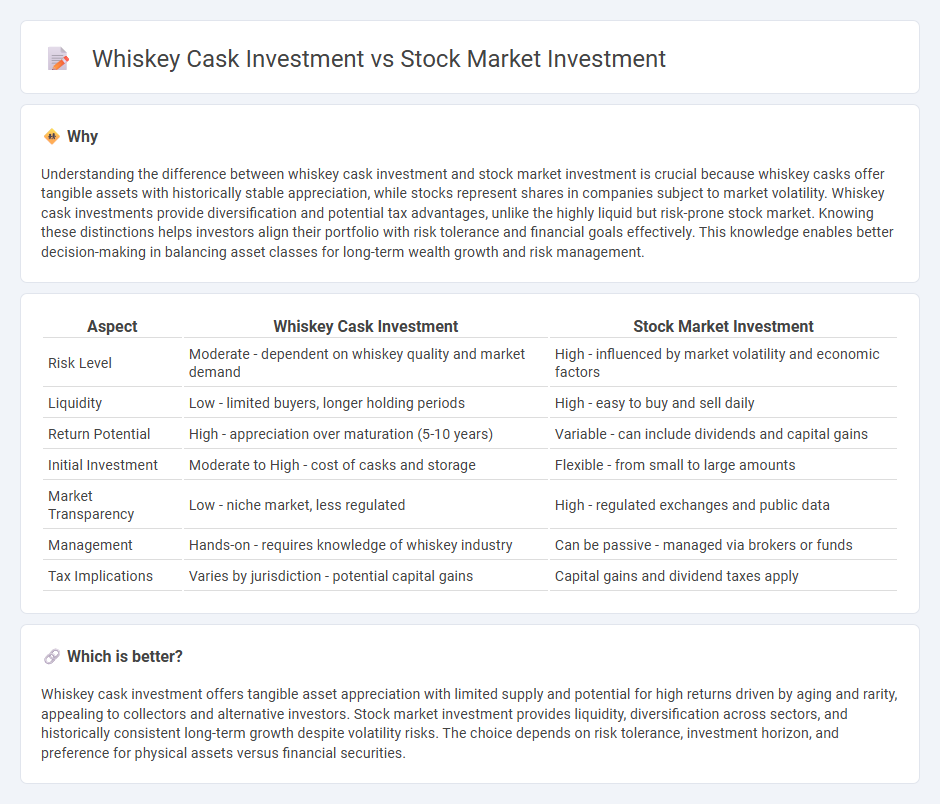
Whiskey cask investment offers a tangible asset with potential value appreciation tied to aging and rarity, contrasting the stock market's liquidity and volatility driven by economic trends and corporate performance. Whiskey casks provide portfolio diversification and inflation hedge benefits absent in traditional stock holdings. Explore the unique advantages and risks of whiskey cask investment compared to stock market opportunities to make informed financial decisions.
Why it is important
Understanding the difference between whiskey cask investment and stock market investment is crucial because whiskey casks offer tangible assets with historically stable appreciation, while stocks represent shares in companies subject to market volatility. Whiskey cask investments provide diversification and potential tax advantages, unlike the highly liquid but risk-prone stock market. Knowing these distinctions helps investors align their portfolio with risk tolerance and financial goals effectively. This knowledge enables better decision-making in balancing asset classes for long-term wealth growth and risk management.
Comparison Table
| Aspect | Whiskey Cask Investment | Stock Market Investment |
|---|---|---|
| Risk Level | Moderate - dependent on whiskey quality and market demand | High - influenced by market volatility and economic factors |
| Liquidity | Low - limited buyers, longer holding periods | High - easy to buy and sell daily |
| Return Potential | High - appreciation over maturation (5-10 years) | Variable - can include dividends and capital gains |
| Initial Investment | Moderate to High - cost of casks and storage | Flexible - from small to large amounts |
| Market Transparency | Low - niche market, less regulated | High - regulated exchanges and public data |
| Management | Hands-on - requires knowledge of whiskey industry | Can be passive - managed via brokers or funds |
| Tax Implications | Varies by jurisdiction - potential capital gains | Capital gains and dividend taxes apply |
Which is better?
Whiskey cask investment offers tangible asset appreciation with limited supply and potential for high returns driven by aging and rarity, appealing to collectors and alternative investors. Stock market investment provides liquidity, diversification across sectors, and historically consistent long-term growth despite volatility risks. The choice depends on risk tolerance, investment horizon, and preference for physical assets versus financial securities.
Connection
Whiskey cask investment and stock market investment both offer alternative asset classes that diversify traditional portfolios and hedge against inflation. Whiskey cask values tend to appreciate over time due to aging and rarity, similar to the potential growth seen in equities through market appreciation and dividends. Investors benefit from tangible asset ownership in whiskey casks and liquidity in stocks, providing a balanced risk and return profile within investment strategies.
Key Terms
Liquidity
Stock market investments offer high liquidity, allowing investors to buy or sell shares quickly during trading hours with minimal transaction costs. In contrast, whiskey cask investments are illiquid assets requiring longer holding periods and specialized market knowledge to facilitate sales, often involving appraisal and transportation complexities. Explore the nuanced liquidity considerations to determine which investment aligns best with your financial goals.
Volatility
Stock market investments exhibit high volatility driven by economic fluctuations, geopolitical events, and market sentiment, resulting in rapid price changes. Whiskey cask investment offers lower volatility due to the asset's tangibility and gradual appreciation influenced by aging, rarity, and demand in the luxury market. Discover detailed comparisons and risk assessments to make informed investment choices.
Asset Tangibility
Stock market investments primarily involve liquid financial assets representing company ownership, which can experience high volatility and fluctuating market valuations. Whiskey cask investments offer tangible, physical assets whose value often appreciates with aging and rarity, providing a unique blend of asset security and potential inflation hedge. Explore the benefits and risks of each investment type to determine which aligns best with your financial goals.
Source and External Links
How to Invest in Stocks: 2025 Beginner's Guide - NerdWallet - To invest in stocks, open an online brokerage account, add money, and purchase stocks or stock-based funds; low-cost index funds and ETFs which track benchmarks like the S&P 500 are recommended for long-term investing with moderate risk, emphasizing consistent investing and a sound plan over short-term trading.
Stocks | Investor.gov - Stocks represent ownership in a company and offer potential for long-term growth but carry risks including price volatility and possible loss of investment, with diversification into multiple stocks and bond holdings helpful to offset risk.
Stock Investment Tips for Beginners - Charles Schwab - Beginners should invest in businesses they understand personally and frequently interact with, aligning investment choices with familiar products and services as part of forming a sound investment thesis.
 dowidth.com
dowidth.com